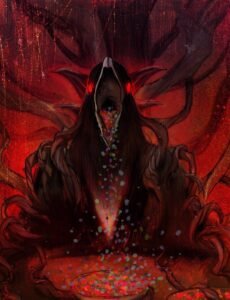J.H. Williams III and W. Haden Blackman – creators
Dave Stewart – colourist
Todd Klein – letter
Image Comics, 2022

In a bizarre future world that has forgotten its history, a reckless thief, Hope Redhood, holds the key to excavating its dark, strange past—if only she and her crew can escape a tyrannical wizard and his unstoppable daughter. But fate will send them all on a path leading to a war between worlds.
ECHOLANDS is a landscape format, mythic-fiction epic where anything is possible—a fast-paced genre mashup adventure that combines everything from horror movie vampires to classic mobsters and cyborg elves, to Roman demigods and retro rocket ships. It’s going to be a helluva ride!
**
Something is out of tune with Echolands volume 1, a collected edition of the first six issues of the ongoing publication from Image Comics.
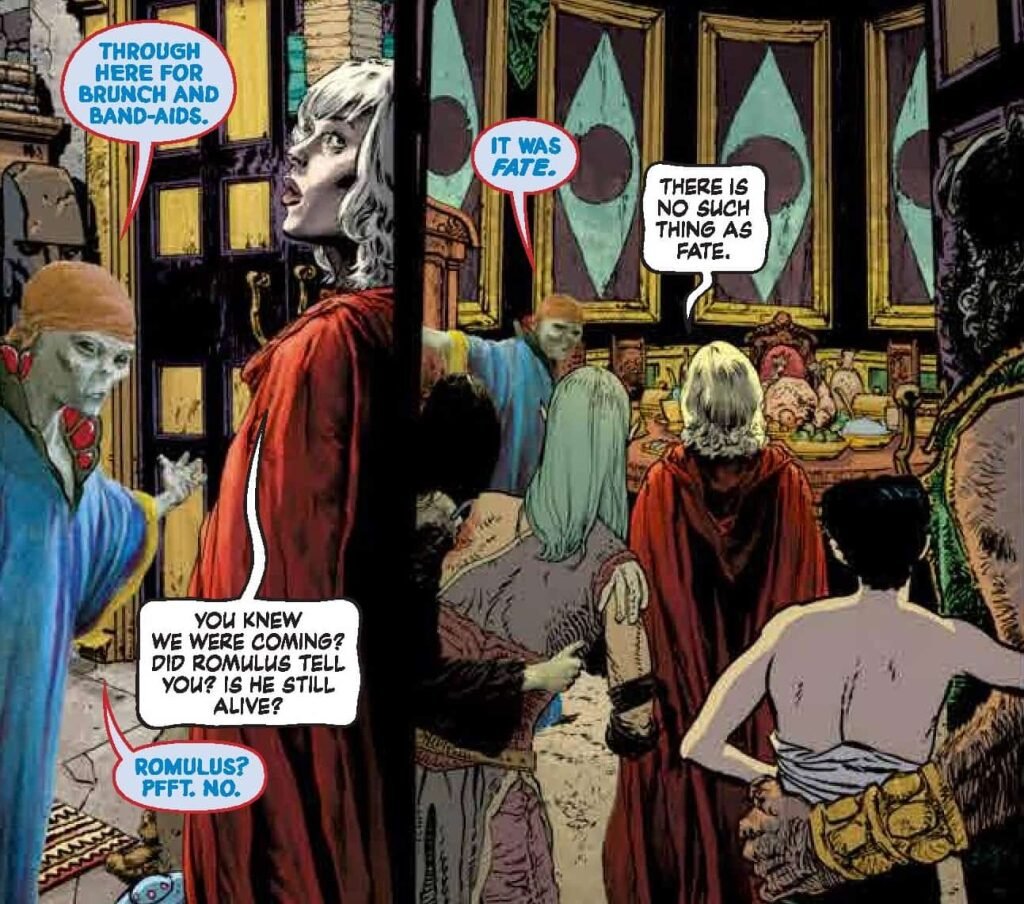
It certainly is not the beautiful art which jangles the senses. Co-creator J.H. Williams III is well-known from his wonderful work on titles such as The Sandman: Overture (which we reviewed back in 2015 https://worldcomicbookreview.com/2015/06/09/gaimans-sandman-overture-and-the-elves-that-come-in-the-night-why-comic-books-release-dates-matter/, Promethea, Batwoman, and Desolation Jones (which we also reviewed, last year: https://worldcomicbookreview.com/2022/07/19/king-of-spies-v-desolation-jones-comparative-review/. An enormous amount of artistic expression and skill has gone into this beautiful book. Some of the artistic approaches are wonderfully innovative.

With that introduction, why does it hit the wrong notes?
Because this humourless work has a star-studded creative team (acclaimed letter Todd Klein, acclaimed colourist Dave Stewart, and experienced co-writer W. Haden Blackman are together a formidable ensemble), many critics have a lot to say about it.
Of the first issue, Gregory Paul Stilber of The Comics Beat https://www.comicsbeat.com/echolands-1-review-jh-williams-iii-w-haden-blackman/ says:
“…this is a breathlessly-paced opening issue that’s more interested in throwing readers into its strange waters than exposition. It’s exciting and it works, mostly on the strength of Williams’ unrivalled ability to mesmerize. But readers hoping for something better resembling a straightforward, easy-to-follow plot structure may be disappointed.”
We think this is incorrect. The plot is a hunt. The main protagonist, a woman named Hope Redhood, has stolen a valuable jewel from the Wizard, named Teros Demond. The Wizard is the ruler of the Echolands. Rose is being hunted for the recovery of the jewel, and she relies upon the ingenuity and skills of her crew of thieves to evade capture and torture. (How she managed to get the jewel is not obvious, but that is not necessary to understand the plot. The heist itself might have been very entertaining.)
Chris Mautner at The Comics Journal notes https://www.tcj.com/reviews/echolands-1-6/, correctly, “And yet despite all this inventive design and thoughtful construction, Echolands feels depressingly inert. There is nothing here to hang your hat on, mainly because the entire cast of characters has, to a man, the personality of drab wallpaper... There’s a chance is all a long, slow burn, and that Echolands will come into its own in its second part, with the sort of characterization and story detail the first so badly lacks. As it currently stands, however, this is a very vibrant and visually-stunning series about which it is nigh-impossible to muster any enthusiasm. “
We do not have an issue with the characterisation of at least some of the players. Rose herself has enough substance to her – her joy at the success of the theft, her increasing struggles to control the power lurking within her, and her unlikely relationship with strong man Cor – to be interesting. Rose’s defence of Rabbit, a young man who appears to be half-reptilian, is admirable. Space god Romulus is an archetype from Jack Kirby’s Fourth World stories and Eternals for Marvel Comics, but is opportunistic in a way none of those high-and-mighty beings would ever have been. The stranded exterminator robot was fun and killed off far too early. And the noble giant mecha is eminently likeable.
Others are indeed far too limp, though. Cor is apparently of the Golden Horde or its ilk, but dresses like a biker and has nothing to him besides a devotion to Rose. The vampire princess is a mush of cliches, a lacklustre foil who repeatedly challenges Rose and her loyalty to the gang. The cyborg elf does not contribute at all. The Wizard himself mouths the worst monologues of self-serving tyrants. By happenstance over the weekend we were reading the 1983 annual of All Star Squadron, with dialogue by Roy Thomas. These old books dating through to the 1980s rely upon the visual appearances of the characters to distinguish themselves from each other: the dialogue is a bland pavement. Except for the hothead in the team to spark controversy (Johnny Quick), there is little to distinguish the personalities of Green Lantern from The Flash from Dr Mid-Nite from The Guardian. This is the sort of level expression of personality we see in Echolands: there’s not a lot of difference at the end of the day between Rabbit and Cor. The techniques of characterisation are 40 years stale.
Ross Hutchinson at Comics Watch, writing about issue 4 https://comic-watch.com/comic-book-reviews/echolands-4-rolling-in-the-deep is much more ebullient about the series:
“Echolands #4 is another perfectly executed chapter in a wildly entertaining journey that mixes so many different genre ideas together that if it were paint you would expect to end up with a grey mess but instead you end up with something that is all the colors of the genre rainbow at once and its beautiful! Enchanting from start to finish as it plays on your psyche with it’s brilliantly executed visuals on both a conscious and unconscious level, still telling a very well paced story packed with all the action and melodrama you could ask for. Quite simply put Echolands continues to be brilliantly flawless and an absolute must read.“
“Grey mess” is an idea we will return to. Rook Geary at Gatecrashers.fan https://gatecrashers.fan/2021/07/27/echolands-1-review/ almost nails it, but does not see a problem:
“When you’re shoving this much raw creativity in the audience’s face from the get-go, sometimes you need a more traditional story structure for readers to cling to, like a life raft in the middle of the ocean. We don’t need a complex story in the first issue, we just need plot momentum and engaging characters to draw us into this world of dreams and nightmares, and they more than deliver that.”
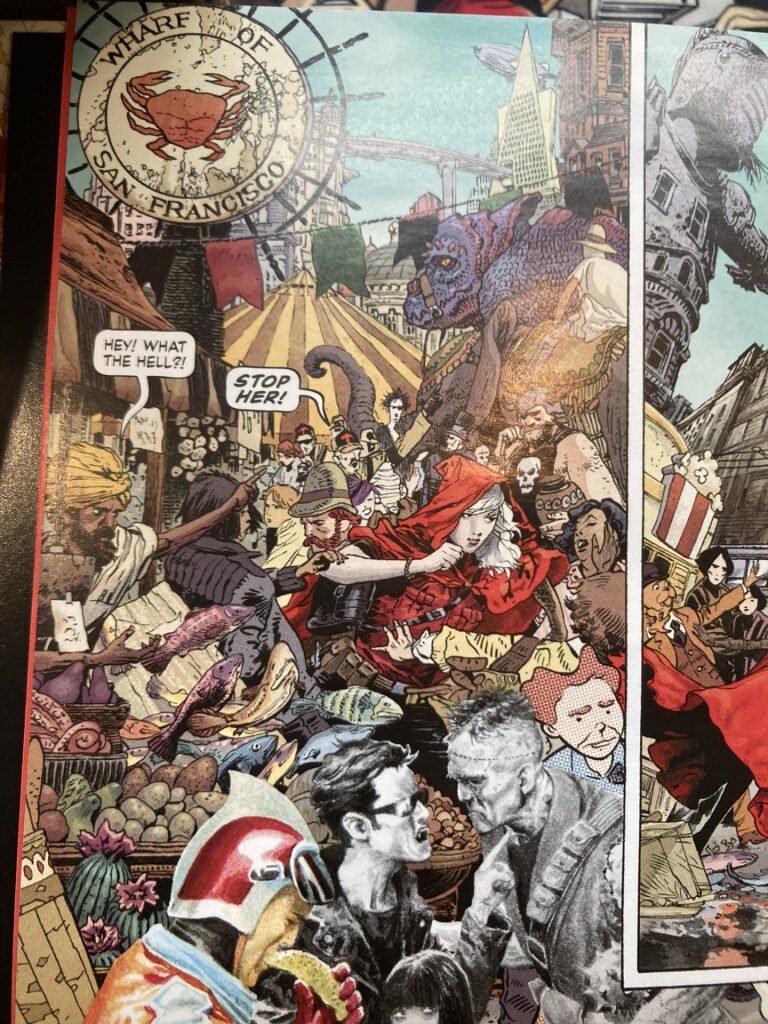
Michael Farris Jr at Geekd Out https://geekd-out.com/review-seeing-red-again-in-echolands-1/ is gushing:
The slew of characters and settings we get blends every imaginable subgenre under the sun. Just when I thought I had seen it all, my eyes are greeted by something out of a western being stabbed by gothic space soldiers (not exaggerating).
All of this is getting to a larger point: This is the type of book that makes comics comics. Try as hard as you like, but capturing the spirit of this book into another platform like TV or a movie would be a monumental task. This book crashes into every childhood imagination trip you had. It’s an incredibly risky book.
In their praise, Mr Hutchinson, Mr Farris Jr, and Mr Geary come close to summarising the problem with the cast and world-building. The story is a bewildering miasma. The implied premise of the title seems to be that the world within which the characters exist echoes pop culture on our earth, although this has not been expressly revealed as yet. And so we witness a messy palate of Japanese mecha; a place of shlock horror vampires, zombies and werewolves; the aforementioned Jack Kirby homage named Romulus; an elf who is part cyborg; a Star Wars-like Emperor and his dedicated daughter / servant / creepy monster; a 1930s gangster; and a chaotic and continuingly evolving place described as being San Francisco but the point at which the colours of the plot completely blur into grey.
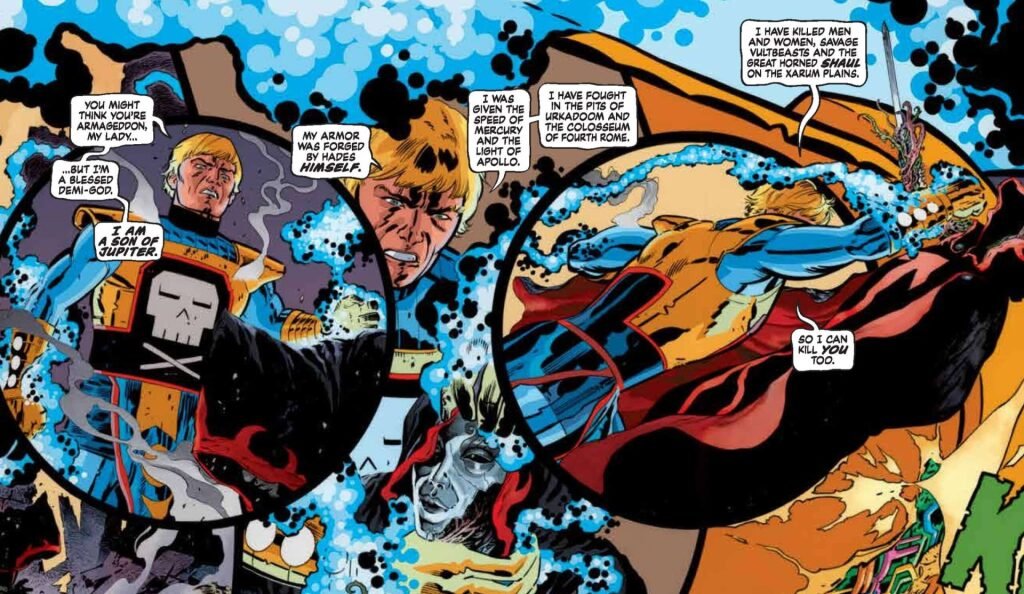
Part of the problem we think is the absence of good editing. There is a piece of dialogue which stands right out – an alien fortune teller begins two consecutive word balloons with the word “But”, suggesting that at least one of these was inserted later without regard for the continuity of the speech. Strategic editorial intervention might have stopped the gangster character being inexplicably enhanced with a violent Kirby-esque energy core: did the creators find the character otherwise limiting after four chapters? And why were two significant subplots in the story confusingly delivered to the reader in two levels – an upstairs and a downstairs – over consecutive pages when they would have been far easier to follow with separate chapters? An innovating way of telling a story is not an effective innovation when executed as a confusing mess.

It seems to us that Echolands in execution is a warped echo of two other titles. Mr Williams has sat at the respective elbows of two maestros of the Anglophone medium, Alan Moore and Warren Ellis. It is Mr Moore’s influence which is repeatedly obvious in Echolands. Mr Moore and Mr Williams worked together on Promethea, a ground-breaking fantasy title published between 1999 and 2005. The protagonist of Promethea inhabits (for want of a better description) the body of teenage student Sophie Bangs. Sophie lives in a parallel universe set in the year 2000 (the Millenium Bug is an actual threat!), and with a contemporary backdrop comes things such as pop culture. By way of balance to the serious mysticism Mr Moore injected into the title, Mr Moore incorporated funny elements into Sophie’s milieu: the inexplicable meme Weeping Ape dotted around the landscape, conveying a subliminal message only someone living in that zeitgeist can understand: an emo boy band The Limp: and other silly advertisements. Mr Williams and his colleagues have tried to use some of these techniques in Echolands, by including at the end of every chapter (singular issue, before collected in this hardcover) an interview between a journalist and the Wizard contained in a two paged newspaper called The Echo. It does not make any sense and detracts from the story. Would a pirate crew really seriously advertise skullduggery in a newspaper? Would the Wizard himself allow a highly disparaging interview to be published about him, including details on how he jailed the interviewer? What worked for Promethea does not work in Echolands.
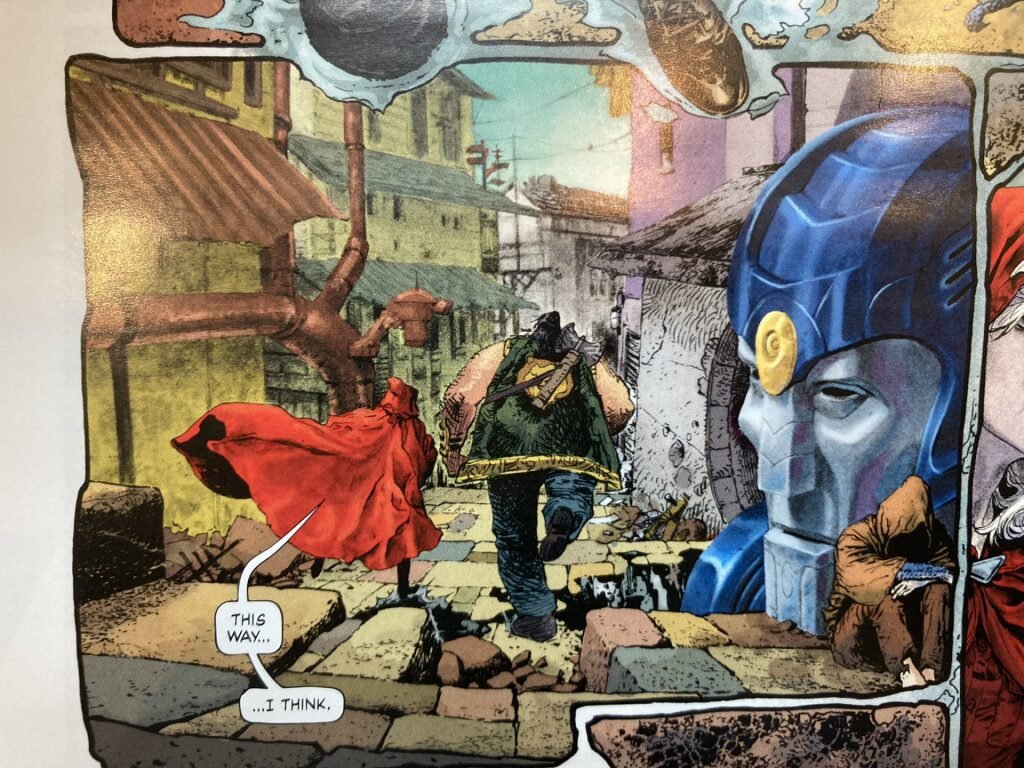
But the major influence of Mr Moore upon this title is not from Promethea. It is from another comic of the same vintage, named Top Ten. Top Ten was a superhero comic published from 1999 to 2001. It was set in a city where everyone has superpowers, and the main characters are police officers. It is a miasma, like Echolands, but one which works because it is fun. In Top Ten, Mr Moore borrows from a variety of different comics and comic book genres to create a detailed backdrop filled with Easter eggs for readers. By way of example, there is a delightfully absurd panel in Top Ten in which one of the characters berates rubberneckers at a traffic accident. The rubberneckers all look very much like Plastic Man, Mr Fantastic of the Fantastic Four, Elongated Man, Doom Patrol’s Elastic Girl and Jimmy Olsen’s alter ego Elastic Lad. Another page is filled with winged passers-by – Marvel Comics’ Falcon, DC Comics’ Dawnstar, DC Comics’ Man-Bat, Marvel Comics’ Vulture, Marvel Comics’ Angel, all placed together for no reason other than for a laugh. Another panel has a pest controller lamenting to a police officer called Dust Devil that when enough super-powered rodents get together, it leads to the sort of cosmic catastrophe that the big US superhero comic book publishers are notorious for: “See, ultramice, they behave sorta like regular science guys… Get enough science animals together, and it becomes a big event. Next thing, it escalates. You get a whole secret crisis-war crossover thing going. inevitably, cosmic powers get involved. You know how it is.” But all Dust Devil wants is to get rid of the mice out of his mother’s house. It is very quirky humour designed for long-time readers of comic books. It does not take itself seriously.
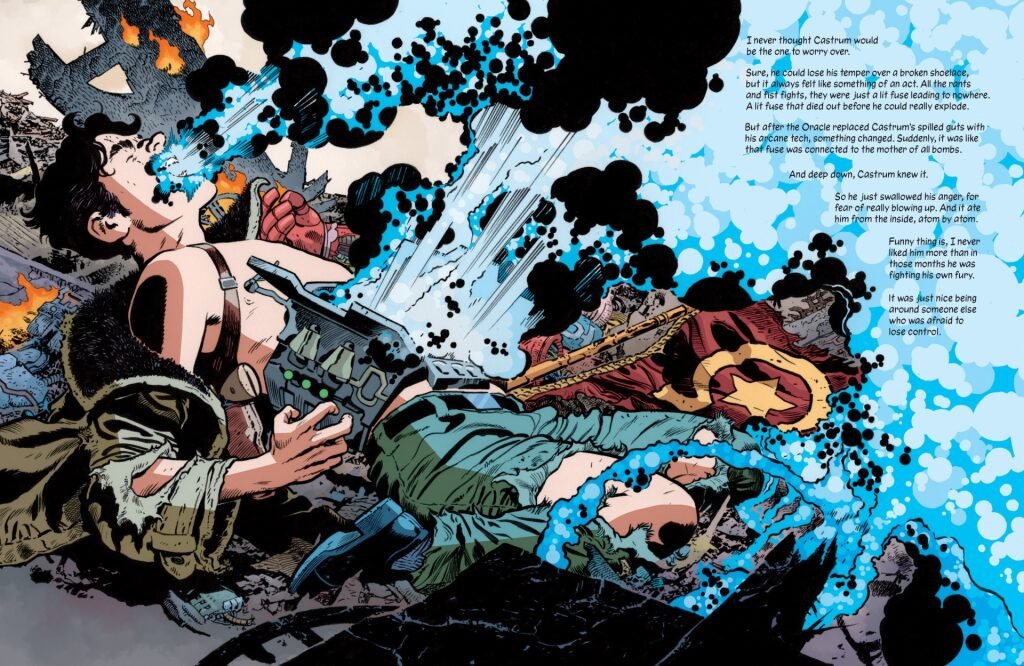
But Echolands does take itself far too seriously. There’s no absurd irony that all of these characters interact, and that their worlds somehow coexist. Put aside the flimsy characters, the cringeworthy dialogue, and the shonky world-building. Echolands is bland because, fundamentally, it is humourless.

